Basic requirements of preventive conservation
Stefan Michalski
Basic requirements of preventive conservation is part of CCI's Preventive conservation guidelines for collections online resource. It is based on a section in "Care and Preservation of Collections" in Running a Museum: A Practical Handbook (PDF Version, 181 KB), P.J. Boylan, ed., Paris, International Council of Museums and UNESCO, 2004.
While developing preventive conservation advice for museums and galleries over three decades, as well as in recent comprehensive risk assessments of museums, galleries and archives, the Canadian Conservation Institute (CCI) has uncovered a short list of common requirements which we call "the basics." These basic requirements are of two types—those that reduce a single catastrophic risk, such as fire suppression, and those that reduce a large number of lesser risks, such as a reliable roof. These basic requirements are so obvious that they can easily be overlooked, but they do need to be in place before following more specific advice on the care of collections.
The list of basics has been organized into three groups—building features, portable fittings and procedures—in keeping with the structure of the CCI poster, Framework for Preserving Heritage Collections.
- Basic requirements provided by building features
- Basic requirements provided by portable fittings
- Basic requirements provided by procedures
- Conclusion
Basic requirements provided by building features
Building features are all the components and systems that make up a functional building, from the obvious, such as the roof, to the less obvious, such as fire control systems. The responsibility for selecting and purchasing building features during construction projects, or maintaining and upgrading them in existing buildings, usually falls to external agencies or their consultants. Getting the basic requirements done well depends on knowledgeable museum clients working with knowledgeable consultants.
A reliable roof
Whether it is part of an enclosed structure or standing alone (Figure 1), a reliable roof sheds the heaviest rains and spring meltwaters. Reliable drainage systems and landscaping carry this water away (Figure 2) rather than letting it pool nearby. In technical terms, museums should design a roof and its drainage systems to survive at least the "100-year storm," if not better. A roof blocks not only water, but also the sun's intense radiation, as well as pollutants that fall as dust or in rain. For objects consigned to the outdoors, such as historic vehicles, agricultural machinery or even archaeological remains, a reliable roof can be one of the most useful acts of long-term preservation.
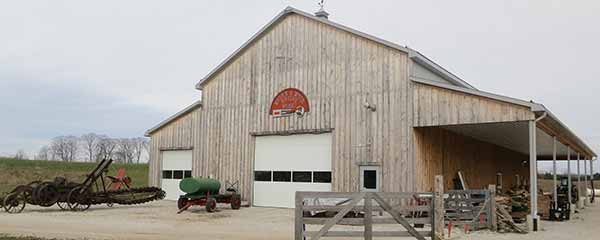
Figure 1. Large objects that must remain outdoors will last much longer when protected by a roof.
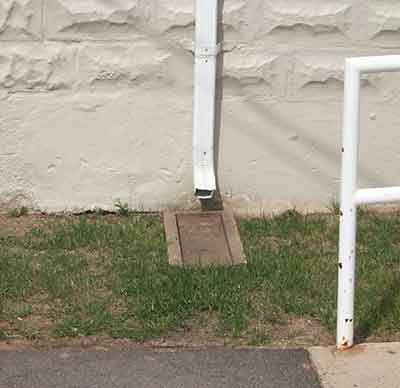
Figure 2. Whether or not a drainage system is good enough to prevent water entering the foundations depends on the local pattern of rainfall and the soil drainage. A long trough that reaches the pavement, in combination with a pavement that slopes away from the building, would be the most reliable.
Reliable floor, walls, windows and doors
A reliable building envelope blocks, or at least reduces, all the agents of deterioration that have sources outside the building, i.e. physical forces (storms, earthquakes, etc.), fire, thieves, vandals, water, pests, pollutants, sunlight, incorrect temperature and incorrect relative humidity. In practice, this means that a reliable museum building is sturdy, weather-resistant, airtight, pest-tight, compartmentalized against the spread of fire, damp-proofed and insulated more than is required for an average structure. When considering a new building, take advantage of low energy, sustainable building designs that provide many of these features. A museum inside a historic building has no choice but to preserve, and to work within, the characteristics of that building (Figure 3).

Figure 3. A museum in a historic building must devote much of its resources to careful maintenance of the foundations, brickwork, woodwork, roof and drainpipes, as well as the grounds, their drainage and security lighting (Glanmore National Historic Site, Belleville, Ontario, 2010).
Fire detection system plus automatic fire suppression system
For many smaller museums where occupants can escape quickly, automatic fire suppression may not be mandatory, but collections cannot escape. They need automatic fire suppression. CCI recommends wet pipe sprinklers (Figures 4 and 5) or a mist system. When the risk of water damage to a collection from accidental sprinkler discharge is calculated, it is much smaller than the risk to the collections from the average incidence of fires in museums in Canada. Consult Agent of deterioration: fire for more guidance on reducing the risk of fire in heritage collections.
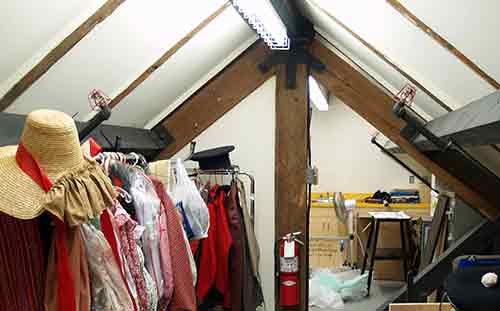
Figure 4. Sprinklers can be installed in close quarters such as this attic used for storage of reenactment costumes.
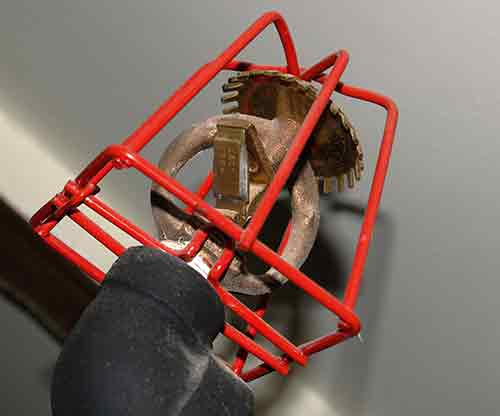
Figure 5. Sprinkler cages reduce the chance of accidental discharge of the sprinklers by accidental collisions.
Adequate locks on all doors and windows
Adequate is a relative term, but a museum's locks should be at least as secure as the locks on a house, meeting reasonable standards of protection, and preferably on par with a local business that is holding easily moved stock. Even a small museum, gallery or archive will need a key control system, with levels of authority and access (Figure 6). Consult Agent of deterioration: thieves and vandals for information on operating a key control system.
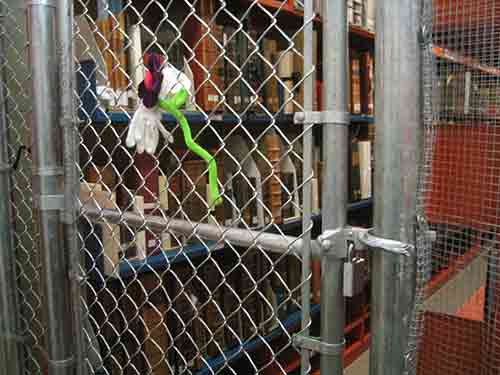
Figure 6. Some interior doors are purely for controlling access, such as this special collection area within a larger storage room. This approach uses the basic security principle of perimeters within perimeters. Keys to each perimeter are available only to select staff.
A detection system for unauthorized entry, plus alarms and knowledgeable response
For display areas during open hours, detection systems with noisy alarms will deter opportunistic amateurs. Reducing losses due to more determined thieves requires a rapid response by trained security personnel and the police. Invite local police for an exchange of information on security issues. For museums that are unoccupied during the off-season, and for which police response time is beyond a few minutes, even good locks and alarms will not save valuable or attractive objects. These may need to be stored in another more secure location during the off-season. Consult Agent of deterioration: thieves and vandals for information on issues related to securing heritage collections against theft.
Basic requirements provided by portable fittings
Portable fittings are the things that enclose or support objects in collections, from small envelopes to large cabinetry. Responsibility for their selection and purchase is often spread across several domains—conservation, exhibits, collection management, building contractors—but sustainable and cost-effective preservation depends on their integration with each other, with the building (described under Basic requirements provided by building features) and with museum operations (described under Basic requirements provided by procedures).
Shelving and plinths
Metal shelving of adequate strength is a basic component of efficient collection storage (Figure 7).
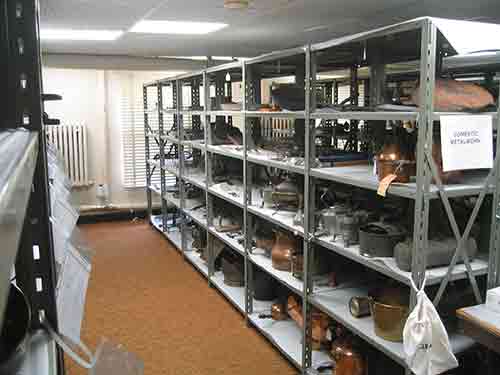
Figure 7. Simple metal shelving can be strong enough to support heavy loads and flexible enough to provide the different heights required for various sized objects. The lowest shelf keeps objects away from flooding on the floor. Keep shelves at least 50 cm from walls.
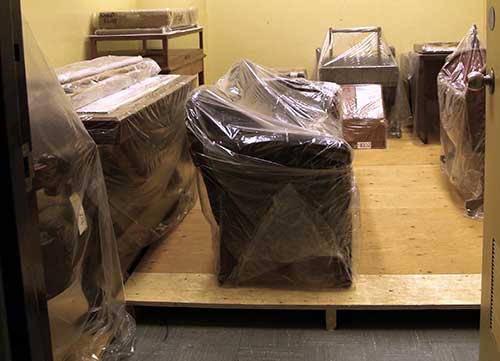
Figure 8. This simple wood plinth greatly reduces the risk of water damage during small floods. Enclosing objects in well-sealed polyethylene film protects against daily, weekly and much of the seasonal humidity fluctuations.
For very large objects, such as furniture, lifting the objects on to simple plinths reduces risks of damage to the objects from minor floods and damp floors (Figure 8). Note that wrapping the polyethylene under the object as opposed to simply draping it over as a dust cover protects the object from trapped damp if the floor suffers rising damp. In this example, the 10 cm gap between the plinth and the floor reduces any temperature gradients that can cause damp, plus the floor is known to be above a warm space. Consult Agent of deterioration: incorrect relative humidity for details on the problem of temperature gradients and bags.
Enclosures, e.g. envelopes, encapsulation devices, bags, boxes, cabinets and cases
All objects that are small and fragile, easily damaged by water and easily attacked by local pollution or local insects benefit hugely by simple packaging in stable materials, such as polyester sleeves or food-grade polyethylene zip-lock bags (Figure 9). Polyethylene enclosures also protect large objects sensitive to incorrect humidity (Figure 8). Where resources allow, closed cabinets and display enclosures reduce risks from external collisions, theft, water from above, pests, pollutants and incorrect humidity (Figure 9). Specialized cabinets can also reduce theft and fire risks. As the primary layer of defense against external pollutants and incorrect humidity, good enclosures are much more cost-effective, sustainable and reliable over time than elaborate mechanical control systems. Integrating the design of the building, its systems and its portable fittings with that of the museum's enclosures is the only path to reliable and sustainable long-term humidity control.
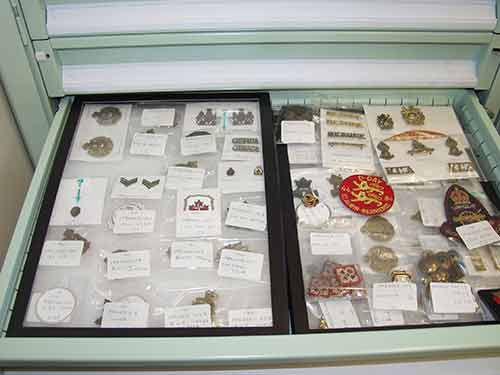
Figure 9. This museum has placed small objects inside individual polyester or polyethylene bags, sometimes with paperboard for added mechanical support and protection. The bags protect the objects as well as allowing large clear labels.
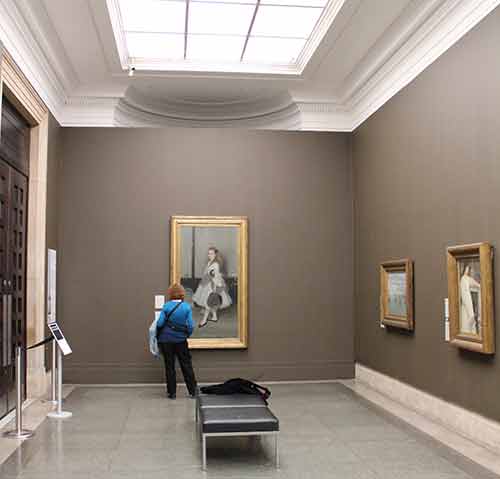
Figure 10a. Even famous museums with famous paintings, despite security guards, mechanical climate control and filtration, are adopting fully enclosed frames with glass fronts to reduce risks from vandalism, incorrect humidity and pollutants.

Figure 10b. Detail of the nearly invisible non-reflective glass fitted discretely within the historic frame. The yellow triangle is drawn on the photo to show where the glass fits between inner and outer frames. In combination with its backing board, the painting is now fully enclosed.
Strong backing boards made of stable materials for delicate flat objects
Backing boards might be considered just partial enclosures but they are worth emphasizing since they form a very simple but effective preservation strategy for many heritage objects: manuscripts, paintings on canvas, paintings on paper and board, wall maps, flat textiles, photographic prints, etc. Backing boards not only block blows from the back, but they also reduce the likelihood that a blow from the front will initiate a large tear or that a corner drop will cause fragmentation. For oil paintings on canvas, impermeable backing boards reduce the risks from hourly and daily humidity cycles because the back of the painting responds much more quickly than the front paint layers. Boards also prevent the access of pollutants that cause embrittlement of the canvas. When combined with a glazing layer on the front and an airtight frame, a backing board provides a painting with the benefits of a full enclosure (Figures 10a and 10b) without which traditional watercolours and photographs would never have survived so well. Consult CCI Note 10/10 Backing Boards for Paintings on Canvas to learn more about types of backing boards and ways to install them.
Basic requirements provided by procedures
Procedures are the many ways that things get done, or are supposed to get done, in an organization, and people are the ones doing them. Some of the procedures listed below produce something concrete, such as stored information; others refer simply to desirable habits. In the long-term, each can be as important to preservation as big ticket items, like a new building.
An inventory of the collections, with off-site backup
An inventory can vary from a simple ledger book to card catalogues to modern databases. As a minimum, record the object's accession number (as attached to the object), its current location (storage, display, treatment, transit, etc.) and a description of the object sufficient for police identification. Keep a backup copy off-site in case a fire, flood or other accident destroys the original. Consider keeping an electronic copy in online data storage, also referred to as cloud storage. Establish access procedures, including control of keys and storerooms. Establish procedures to record when and where objects are moved. Consult the Canadian Heritage Information Network's Making Up the Rules: New Documentation Standards for Canadian Museums for guidance on documenting heritage collections.
Reasonable order and cleanliness in storage and displays
The word "reasonable" is crucial. It does not mean spending most of your time on obsessive neatness, which provides very little benefit and can be counterproductive if one neglects bigger risks. It means keeping sufficient order so that:
- objects are not crushing each other
- inspection and surveys are quick
- objects can be retrieved without moving more than two other objects
- objects can be retrieved from storage within three minutes of starting at the documentation system
It means that objects are raised off the floor so as not to be affected by small floods and that cleaning the floor is easy without harming the objects (Figures 7 and 8). It means that storage and displays are sufficiently clean so that pests are not given habitats, metals do not accumulate corrosive layers of dust, and porous and difficult-to-clean objects are not rapidly soiled.
Regular and sufficient inspection of collections, in storage and on exhibition
Regular and sufficient varies with the hazard. For pest management, annual inspection is recommended. Best practice means inspection of all the collections and the building perimeter, but when that is unrealistic, it makes sense to focus on the most vulnerable and valuable collections and to look for signs of the relevant insect (e.g. clothes moth debris in wool or feathers, frass from borers in wood). At the very least, place insect traps strategically and inspect them. For more details, consult the Detect column of Progressive scales of IPM components under Agent of deterioration: pests. For theft management, focus on the most vulnerable and most valuable objects—a full inventory may be feasible only once every few years, but valuable and portable objects warrant a more frequent cycle. Although pests and theft are the primary drivers of systematic inspection, other risks—water damage, pollutant damage, light damage, mould, etc.—are reduced when one looks for signs of pests and theft from time to time.
All problems of sustained damp are addressed quickly
Damp is a rapid and aggressive agent of deterioration, as well as ubiquitous. It places objects at risk from hazards such as mould, corrosion and irreparable deformation, often within hours or days. The usual sources of damp are small water leaks, condensation due to large drops in temperature and rising damp from the ground. In these cases, move the collection away from the damp—until the water leak is fixed, the temperature is stabilized or the rising damp is stopped. Consult Figure 5. Sources of incorrect relative humidity under Agent of deterioration: incorrect relative humidity to predict possible sources of damp in your heritage building.
Understanding and acting on too much light and ultraviolet
Both direct sunlight and powerful electric light can destroy, in months, the colours that may have lasted a century or more by good fortune or good housekeeping. Some colours cannot even tolerate moderate light intensities without being lost in a few decades. There is no easy solution, but the most important step is identification of the most vulnerable colours in the collections (Figures 11a and 11b). If you know nothing about which colours are vulnerable, then you can simply assume that objects with the shortest history of prior exposure (i.e. those that look pristine) are the most vulnerable (e.g. an old quilt recently donated from a family that kept it in storage, a painting that was kept in a study collection or anything brand new). Consult the Light Damage Calculator as well as Agent of deterioration: light, ultraviolet and infrared for more guidance on the fading of colourants.
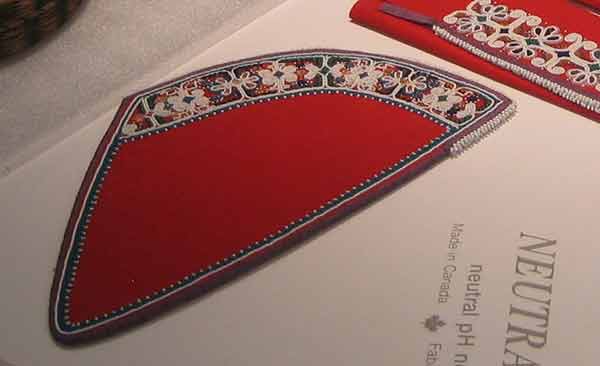
Figure 11a. Mi'kmaq ceremonial dress. The coloured beads are not vulnerable to light. The red felt is moderately vulnerable (probably alizarin dye), but the purple silk edging was highly vulnerable to light when made and has already partially faded. (New Brunswick Museum, Saint John, New Brunswick, 2006)

Figure 11b. Detail of Mi'kmaq dress in Figure 11a, showing the purple edging that has partially faded.
Community and staff understanding of, and engagement with, the museum's mission
Collections in museums, galleries or archives are sustainable only if the community supports the institution's mission and only if staff understand the characteristics of the collection that support that mission. Unfortunately, local knowledge, both practical and values-based, can be lost as staff and volunteers turn over. Capturing this knowledge depends on mentoring and documentation (Figure 12). On the other hand, community knowledge and values will also change as generations change. Sustaining the museum and its collections requires the engagement of all generations. Although these museological issues may seem out of place in a list of otherwise technical requirements, they provide the criteria against which any conservation actions, basic or not, will be judged.

Figure 12. Consultations between conservator David Hanington and Mi'kmaw educator Helen Silliboy with regards to the sequencing of the pages of the rare Miawpukek prayer book dated c. 1800. Further details on this project can be found on the Miawpukek Mi'kmawey Prayer Book website.
Conclusion
These basics may seem obvious, but the biggest museums in the world continue to suffer from roof leaks, avoidable thefts, insects, fires, mould, overwhelming daylight, loss of community, etc.
In a world where being green has been added to "doing it all" with fewer resources, only preventive conservation approaches that integrate the basics of building features, portable fittings, procedures and people will be sustainable. For example, maintenance of a good but never perfect roof can be combined with the placement of water-sensitive objects in water-resistant enclosures and the inspection of both after a heavy rain. Another example could include combining good but imperfect doors with good but imperfect locks, detection systems, alarms and good but imperfect response, all backed up by an up-to-date inventory and object identification data.
In the conservation resources throughout the CCI website, with their numerous suggestions, you will need to decide what advice is a priority and what is not for your institution or organization. This requires a risk management approach. All the basics, on the other hand, are probably (though not certainly) important to your situation.
© Government of Canada, Canadian Conservation Institute, 2018
Published by:
Canadian Conservation Institute
Department of Canadian Heritage
1030 Innes Road
Ottawa, ON K1B 4S7
Canada
Cat. No.: CH57-4/7-1-2018E-PDF
ISBN 978-0-660-28049-3